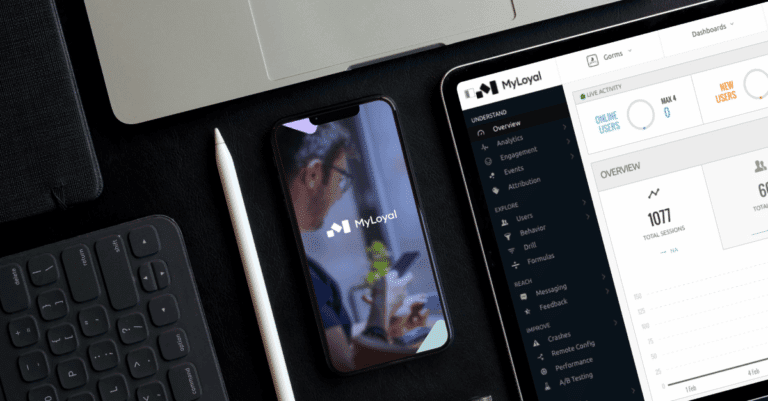How To Make First-Party Data
Work For You
Data this. Data that. People are obsessed with data right now, particularly customer data and there is a very good reason for it. It is essential for companies to achieve multiple goals, such as retaining more customers, optimising marketing spending and increasing sales/traffic to store; but that is just the tip of the iceberg. With third party cookie data coming to an end, marketing teams must accept a future where consent-based advertising is the norm.

Table of Contents
This is all well and good, but the rising number of privacy laws and the crackdown on third-party cookies have forced the hand of many companies, initiating a re-think of their data strategy. As we take another step forward into an increasingly cookieless world, next-generation loyalty programs are going to gain a prominent place for companies wanting to create a seamless customer experience; through relevant offers and information. Enter a primary source of first-party data. Let’s break down the intricate world of data and loyalty programmes
Let's Start at the beginning: First-Party Data & Zero-Party Data
First-Party and Zero-Party Data could be terms you have seen numerous times or have never heard of, so let’s break it down.
First Pary Data (FPD):
The information your collect through your own channels; including your website, mobile app, Point Of Sale (POS) or any other information you have collected. It is one of the most trustworthy and accurate types of data out there and there are minimal privacy concerns involved. Typically this data includes usage patterns, purchase baskets etc. The more sources you have connected, for example, your POS or a loyalty app, the more accurate your customer profile is.
Zero Party Data (ZPD):
This is the information that your customers willingly or proactively share with you, for example from profile building or in-app information. This data covers a wide range of topics that normally would be difficult to predict, such as first or last name, data of birth (DOB), favourite store and their satisfaction rates. Thankfully there are numerous ways to collect this data but the fan favourite is through a loyalty program.
Why is Zero-Party Data so important & how do we capture it correctly:
It is fair to presume ZPD holds to answers to all our problems when it comes to customer personal preferences. This is all well and good but it must be collected ethically, otherwise you are paralleling to a stick situation – so how do we do this?
Let’s focus on millennials for a quick moment here, data sharing in return for value is very common, but by providing that information the customer has an expectation of better value. It is essential that after you have collected this new information, you provide better value to the end-user, otherwise you will end up misleading your customers, which is detrimental to your brand. A customer’s willingness to share their information can be heavily affected by their opinions on the type of value you are offering – they might not be as attracted to a one fits all discount or an irrelevant product as they would be a long-term member bonus. Customers might also be put off if you are offering a value add that doesn’t apply to them; imagine you live in Copenhagen but you keep getting offers to visit a store in Berlin.
The value/incentives you offer have to be relevant. Otherwise, they will fall flat. In order to capture more information you need customers to complete their digital profiles, you need this information to make more attractive offers, so your customers will provide more information and purchase your products. It is very much like a dog chasing its tail – but how fun is that!
A great way to get the ball rolling is to offer birthday gifts for date of birth entry or having customers enter profile details as part of the onboarding process. The basic rule of thumb is to ask as few question as possible on the registration form, so you dont deter people from joining in the first place. If you focus on getting the essentials; name, email and location, you can prevent impatient customers from leaving, increasing your enrolment rates, while still having enough information to retain them down the line. A double win!
How can First Party Data be used to grow your business?
The goal for pretty much every business in the world, how can we harbour this resource to help us grow? You have collected the data, now what? The key to this is to have a wholistic customer full 360 overview by combing all your data sources. A little secret short-cut? POS system and loyalty program integration. It. is. A. gamechanger. We have explored the power of POS X Loyalty before – check it out here.
The 2nd step is to have all the data stored in one easily accessible place, allowing you to have a lifecycle engagement with your customer at all points in time. It is all about understanding your customers behaviours, picking up cues along the way that can provide easier ways to target them with personalised accurate offers.
Let’s break it down further:
Understanding Your Audience: What if it was possible to take a little peak inside customer’s psych? Jackpot right? With 1st party data you can! FDP provides a deep and meaningful insight into your customer and their preferences. It creates the perfect foundation for you to gauge your customer preferences, purchase patterns, and many other things. Think of it like a fly on the wall, hearing everything you need to hear to create the perfect personalised target offer.
Creating an Omni-channel Experience: Let’s cut to the chase. Omni-Channel experiences are the way of the future. Let’s not try and kid ourselves. They provide an experience like no other strategy, created by mapping the customers digital footprint and providing proactive services to them. At this current time, it cannot be beaten. It is ONLY possible with first party data analysis. From on omni-channel experience to reach its full potential it requires quick and accurate analysis of your data and with that a swift strategy execution; but when done successfully it is extremely powerful.
Designing Targeted Campaigns and Strategies: Something we are seeing a lot of currently, is brands investing heavily in marketing and promotions but failing to receive the anticipated return of investment (ROI). One of the main reasons for this is because their campaigns are missing the mark, not appealing to their audience and falling flat. With 1st party data you will always have a finger of the pulse, knowing which campaigns are having more engagement than others. By incorporating 1st party data into your marketing strategy and campaigns you can design targeted campaigns that you are sure will strike a chord with your audience, increasing your engagement and building loyalty within the industry. A competitive advantage? Yes please.
Key Take Aways:
In a world of stricter privacy laws it really is work smarter not harder. With shifting data tracking trends, zero and first-party data are the only source of reliable information that can give you that cutting edge. Loyalty programs not only help capture the information but also are vital to leverage it successfully. Offering accurate value to your customers creates a clear flow of reliable data that can be used to benefit both you and your customers.
Have we got you thinking about how you are utilising your first party data (or even add zero-party data)? Ready to start building your program or just want some more information? Check out our solution page or why not get the ball rolling and book a demo with our team today. Loyalty of the future today after all.
Like what you have read? Sign up to our newsletter
By entering your email address, you consent to our Privacy Policy
